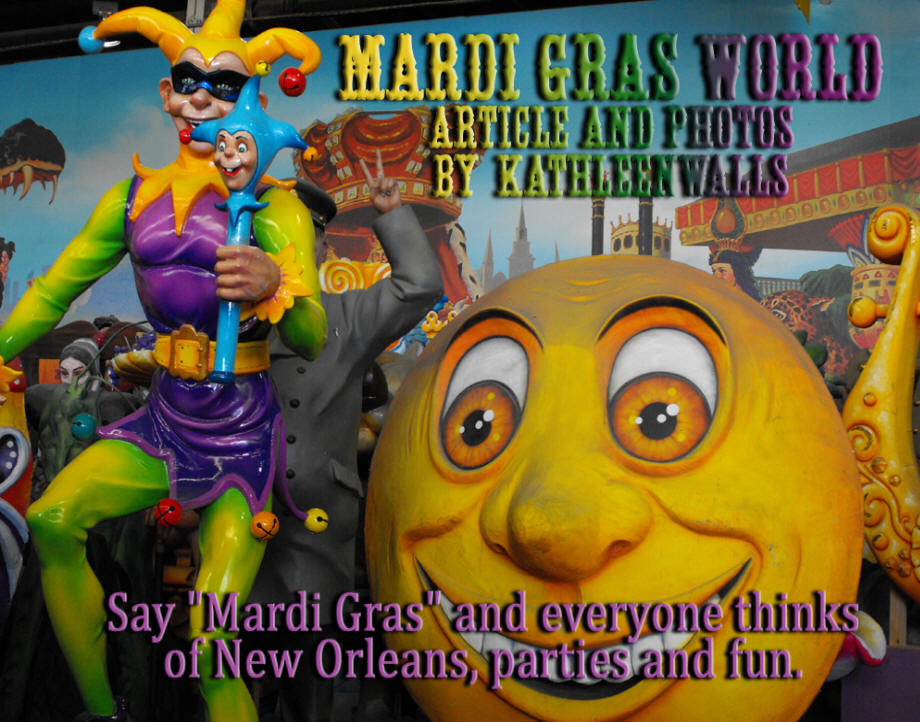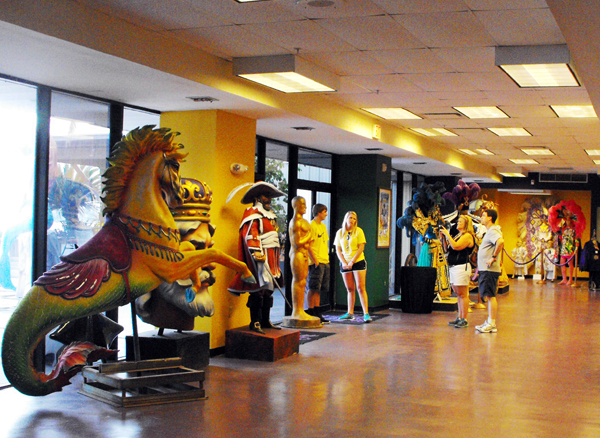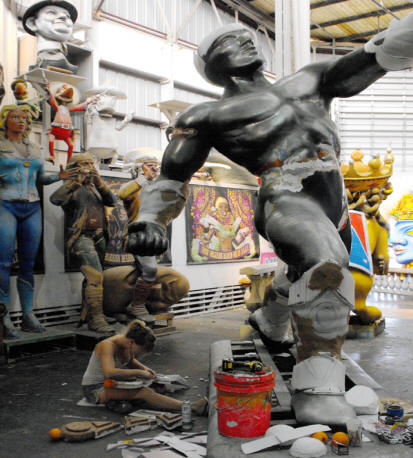|

Not many people think of the work and
effort it takes to put on a world class spectacular event each
year. One place represents that year round part of Mardi Gras
more than any other in the world, Blaine Kern's Mardi Gras
World. This is where you can see Mardi Gras in action year
round. Since 1947,
Blaine Kern Studios has built those stunning parade floats for
Mardi Gras and lots of other events as well.
 |
| Entryway to Mardi Gras World |
I recently visited Rock Ranch
(see article) and loved the Chick
fil A chicken
there. Blain Kern also built the four-story-tall cow that graces
the Atlanta Braves baseball stadium. They build for such well
known names as Universal Studios,
Walt Disney World, Toho Park in Japan and many other
entertainment centers. But Mardi Gras is where it all began and
the first focus of the company. No wonder Blaine Kern is known
as "Mister Mardi Gras."
This is a "living museum" as well as actual
workshop type of
attraction rather than a classic museum and the tour is so much
fun. Just entering the building, you feel like it is a fantasy
world. Costumed mannequins representing many of the past Mardi
Gras maskers line the walls.
 |
| Artist at work |
Our guide, Kyle , explained that for Blaine Kern, Mardi Gras is
an all year long event. There are 50 parades, each of them with
their own theme, spread out over 12 days but as soon as one Ash
Wednesday arrives, Blain Kern starts out building for the next
season.
Kyle took us into the prop shop first.
One young female artist
was hard at work sculpting details for a float figure. She was
seated on the floor totally dwarfed by the far-larger-than-life
figure of a heavily muscled male super hero who looked like The
Hulk and appeared about to charge at the bad guy at any moment.
I was fascinated.
Our guide explained "This is where all the
props are made. There are three basic stages to creating the
props, sculpting where we use sculpting
station to Styrofoam sculpt, then the paper mache station where
we take flour, water and brown paper and cover the Styrofoam and
painting station.
We use paper mache for three reasons, for
recycling. You see a lot of
random upper bodies here. We can reuse a prop the paper
mache lets create a whole new prop by covering it with paper
mache.
Secondly for its
for structural purposes Some
flexible material cannot stand up to the elements so we cover it
with paper mache and it makes it a lot more durable.
Thirdly. it
is difficult to paint Styrofoam so we cover it with paper mache
and it is a lot easier to paint."
 |
| Whiskey Rebellion figure being
redone |
We moved on to the next area where he showed us how the props
from artists graphic image were created by cutting several
sections of Styrofoam with a jigsaw then taping or gluing the
layers together. He explained it is like assembling a three
dimension puzzle.
The attention to detail and the creation of
such lifelike props in such overpowering sizes are amazing. He
showed us how an previous year's
Egyptian pharaoh was turned into a 16th century
aristocrat to represent Queen Anne's War for this year's parade.
The fiber optic work is so detailed that it
requires a lot of workers. Leviathan has 50,000
fiber optic lights on
him. He is a signature float so possibly about 50 people will
have hands on him: 30 artist and 20 builders.
 |
| Collection of heads waiting to
be reused |
Other models are made from fiberglass since it lasts a lot
longer. Unique pieces like this can be as old as 35 years old.
They can be reused over and over by using the paper mache over
it to change it to fit whatever is needed that year.
One great
example is a Paul Revere for this year's "Great Battles" theme.
The horse was created ten years ago as
a race horse with a jockey on him. The jockey was removed
and a brand new Paul Revere was seated on him.
After the prop shop, we moved into the
warehouse. He showed us the Disney floats for the Disney World
Mardi Gras Parade.
 |
| One of the signature floats
complete with restrooms |
A huge train called Smokey Mary was a big signature float with
lots of fiber optic lights on it and can hold 200 people. Smokey
Mary and Leviathan actually have moving parts and blow out
smoke. They even have bathrooms built in them. Some are double
and triple decks.
Tires are different, There is no air but are solid rubber.
Maximum speed is about 15
miles per hour but on parade routes they usually go about
three or four mile per hour.
A new float might cost about $50,000 and a revamped older
one about $10,000.
It is so different seeing them here than it
is when you see them in a parade.
We saw Rocky, a huge lion, Abe Lincoln,
Count Dracula, the Three Stooges, Beauty and the Beast and
countless other figures. This is a huge fantasy land where you
are surrounded by the stuff of dreams and nightmares. I felt
like a big kid again. I didn't want to leave and return to the
real world at the end of the tour. I bet you will feel the same
when you visit. A convenient way to see Mardi Gras World and
more of the Big Easy is via the
Hop on Hop off Sightseeing Bus. It saves lots of time and
fighting traffic. New Orleans is not the eaisest sity to
navigate.
For
more info:
www.mardigrasworld.com/
|